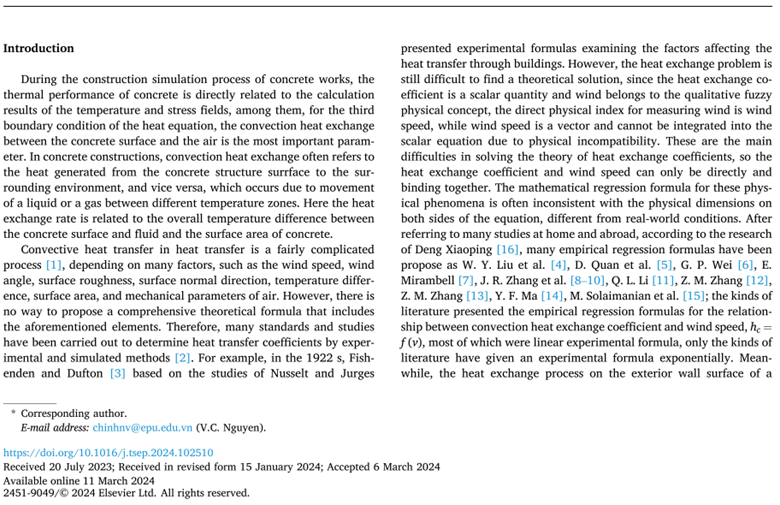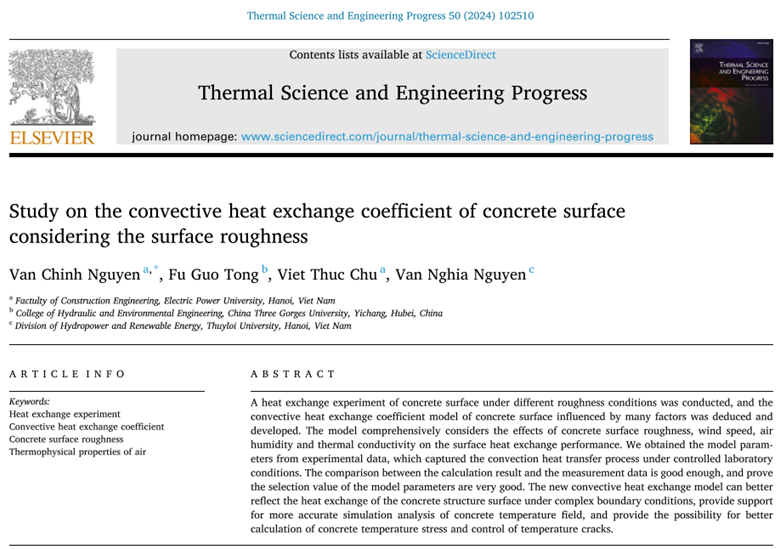Study on the convective heat exchange coefficient of concrete surface considering the surface roughness
Study on the convective heat exchange coefficient of concrete surface considering the surface roughness

Abstract
A heat exchange experiment of concrete surface under different roughness conditions was conducted, and the convective heat exchange coefficient model of concrete surface influenced by many factors was deduced and developed. The model comprehensively considers the effects of concrete surface roughness, wind speed, air humidity and thermal conductivity on the surface heat exchange performance. We obtained the model parameters from experimental data, which captured the convection heat transfer process under controlled laboratory conditions. The comparison between the calculation result and the measurement data is good enough, and prove the selection value of the model parameters are very good. The new convective heat exchange model can better reflect the heat exchange of the concrete structure surface under complex boundary conditions, provide support for more accurate simulation analysis of concrete temperature field, and provide the possibility for better calculation of concrete temperature stress and control of temperature cracks.
Introduction
During the construction simulation process of concrete works, the thermal performance of concrete is directly related to the calculation results of the temperature and stress fields, among them, for the third boundary condition of the heat equation, the convection heat exchange between the concrete surface and the air is the most important parameter. In concrete constructions, convection heat exchange often refers to the heat generated from the concrete structure surrface to the surrounding environment, and vice versa, which occurs due to movement of a liquid or a gas between different temperature zones. Here the heat exchange rate is related to the overall temperature difference between the concrete surface and fluid and the surface area of concrete.
Convective heat transfer in heat transfer is a fairly complicated process [1], depending on many factors, such as the wind speed, wind angle, surface roughness, surface normal direction, temperature difference, surface area, and mechanical parameters of air. However, there is no way to propose a comprehensive theoretical formula that includes the aforementioned elements. Therefore, many standards and studies have been carried out to determine heat transfer coefficients by experimental and simulated methods [2]. For example, in the 1922 s, Fishenden and Dufton [3] based on the studies of Nusselt and Jurges presented experimental formulas examining the factors affecting the heat transfer through buildings. However, the heat exchange problem is still difficult to find a theoretical solution, since the heat exchange coefficient is a scalar quantity and wind belongs to the qualitative fuzzy physical concept, the direct physical index for measuring wind is wind speed, while wind speed is a vector and cannot be integrated into the scalar equation due to physical incompatibility. These are the main difficulties in solving the theory of heat exchange coefficients, so the heat exchange coefficient and wind speed can only be directly and binding together. The mathematical regression formula for these physical phenomena is often inconsistent with the physical dimensions on both sides of the equation, different from real-world conditions. After referring to many studies at home and abroad, according to the research of Deng Xiaoping [16], many empirical regression formulas have been propose as W. Y. Liu et al. [4], D. Quan et al. [5], G. P. Wei [6], E. Mirambell [7], J. R. Zhang et al. [8], [9], [10], Q. L. Li [11], Z. M. Zhang [12], Z. M. Zhang [13], Y. F. Ma [14], M. Solaimanian et al. [15]; the kinds of literature presented the empirical regression formulas for the relationship between convection heat exchange coefficient and wind speed, hc = f (v), most of which were linear experimental formula, only the kinds of literature have given an experimental formula exponentially. Meanwhile, the heat exchange process on the exterior wall surface of a building includes many parameters, such as convective heat transfer, radiant heat transfer, and phase change. Therefore, to facilitate calculations, the authors A. G. Huang (1995) [16], N. H. Deng et al. (2001) [17], W. M. Cao et al. (2002) [18], N. Liu et al. (2003) [19] described various surface heat transfer characteristics due to surface heat exchange and is considered to be a fixed value. As early as 1977 R. J. Cole et al. [20] believed that the equation simulating the forced convection heat exchange process involves the wind effect that could be expressed by Reynolds (Re) number. The research of T. Cebeci et al. [21], the convective heat exchange coefficient is calculated based on Nusselt number.
The heat exchange coefficient is known to depend on the geometry, fluid properties, motion, and in some cases temperature difference [22], where surface roughness is one of the parameters that affect the convection heat exchange coefficient, therefore, many authors below have studied this issue. In 1998, H. J. Rang et al. [23] have studied that the increase in surface roughness can yield higher heat transfer performance of the duct. The author used triangular ducts to simulate the triangular passages of a heat exchanger to evaluate their performance to the pipe heat exchanger model. Research results show that triangular ducts have higher surface roughness values providing greater heat transfer coefficient when using the same pump capacity. Nondimensional expressions used to predict the heat transfer coefficient and friction factor for triangular ducts fabricated with different surface roughnesses. W. Roetzel et al. [24] through experimental experiments by temperature fluctuation technique evaluating plate type heat exchanger. The author proposed a heat exchange coefficient based on heat transfer data in the form of Nu/Pr1/3 as a function of Re. The local convective heat exchange coefficient for a hot plate with laminar parallel air flow is given by J. P. Holman (2010) [25]. In 2003, R. D. Clear et al. [26] by rooftop surface heat transfer measurements determined the convection heat exchange coefficient as a function of surface temperature difference, wind speed, wind direction, roof dimensions, and surface roughness. The formula that the author has given in the form of the Nusselt function taking into account the surface roughness parameter. B. Li et al. [27] developed the stochastic equations for a slab whose surface roughness or convective boundary condition is spatially correlated with correlation lengths ranging from 0 (white noise) to a length long in comparison to the slab thickness. L. Ventola et al. [28] experimentally investigate the potential of the DMLS artificial roughness, optimized for convective heat transfer enhancement, in manufacturing flat and finned heat sinks for electronics cooling. In the study of Yunlu Pan et al. [29], the amplitude parameter Ra is the average deviation and distance parameter Rsm of the rough surface evaluation configuration and was selected as the main parameter affecting the effective shear margin. The study showed that the effective boundary slip caused by the surface roughness of the wet rough surface completely keeps negative and decreases further with increasing Ra or decreasing Rsm. F. Sugita et al. [30] conducted a series of wind tunnel experiments to studied the effect of surface roughness distribution on the evaporation process. The results of the study found that an effective roughness distribution can be used for evaporation and roughness parameters.
The major objective of this paper is to present a more comprehensive modeling for concrete surface heat exchanger process. Literatures shows that there are many differences between previous studies, which may be due to different conditions and measurement methods (e.g. methods of calculating heat transfer, reference temperature, temperature stratification, ventilation, room and surface size, and types of loads). Although the aforementioned studies have been known for a long time, no officially accepted theory can accurately describe convective heat transfer in the presence of surface roughness of concrete. In most of them, the influence of surface roughness is considered as a constant representing a certain type of surface. These models have not established a specific mathematical model showing the effect of changes in surface roughness to the convection heat exchange coefficient. The literature about the approach is very limited, with only a few brief descriptions of the method without detailed solutions. To bring this problem to the light further research is needed. Therefore, in this paper, the author will further propose a new convective heat exchange (CHE) coefficient model for the problem of controlling the temperature of concrete structures based on actual experimental data. The main difference between the model proposed in this paper and other model mentioned above is that the new CHE model comprehensively considers the comprehensive effects of concrete surface roughness, wind speed, air humidity and thermal conductivity on the surface heat exchange performance.
In the following sections, the experimental methods and results are first introduced, followed by the new convective heat exchange coefficient model, determine the parameters that affect the CHE coefficient. Based on the experimental results, the parameters of the model will be determined and tested. Finally, the comparison between the simulated and measured results will be presented.
https://www.sciencedirect.com/science/article/abs/pii/S2451904924001288
